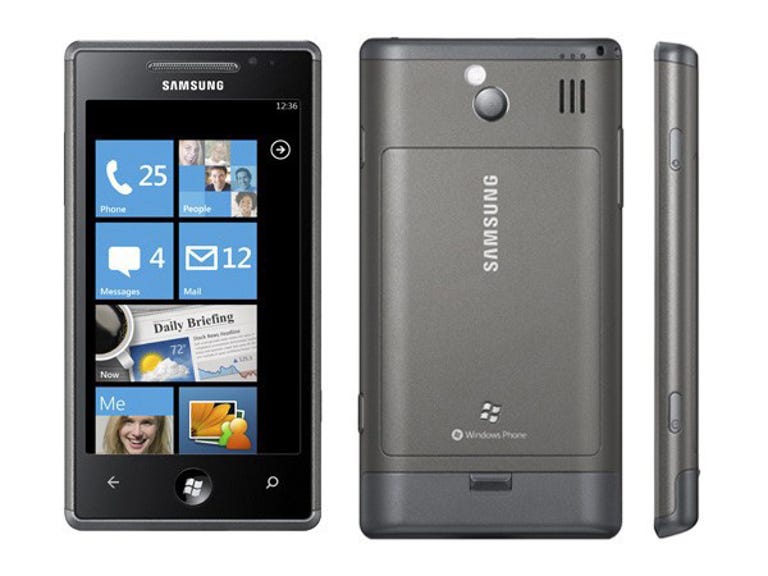 Why You Can Trust CNET
Why You Can Trust CNET Samsung Omnia 7 review: Samsung Omnia 7
Though so much rides on the performance and experience of the Windows Phone platform, the Omnia 7 is a beautiful phone either way.
Super-sleek
Trying to pick and choose between the Windows Phone 7 launch range poses a rather unique problem. A glance at Microsoft's Australian Windows Phone website illustrates this perfectly; five very similar devices standing in a row, with nearly matching specs and features, and reasonably similar price tags. The challenge here is to look a little closer — the differences, and the devil, are in the details.
The Good
The Bad
The Bottom Line
The Samsung Omnia 7 jumps out immediately. Carrying with it some of Samsung's now-refined design decisions, the Omnia 7 is sleek, sturdy and well-crafted. The handset, with its rounded edges, is lovely to hold, the touchscreen is large and feels slippery, and the battery sits flush with its surroundings, clicking into place when returned to its position on the rear of the phone. There's a 3.5mm headphone socket on the top of the handset beside a micro-USB port protected by a sliding door, and similar to the Galaxy S, the screen-lock button lives on the right-hand side — in line with your index finger if you hold the phone with your left hand.
If there's only one reason to choose the Omnia over the offerings from LG and HTC, it's the 4-inch Super AMOLED touchscreen. We've been lucky to have four of the five WP7 launch phones in the office for concurrent reviews, and side by side there is no comparison. Though the screens of the HTC and LG phones are perfectly usable, the Super AMOLED display on the Omnia 7 seems fit to bursting with vibrant colour and sharpness. It also is the best display for reading outdoors where direct sunlight only partially impair visibility, unlike with older TFT LCDs.
If we find fault with any part of this phone's physical design, it's Samsung's use of touch-sensitive navigation buttons. Like all WP7 devices, the Omnia 7 has three dedicated nav-keys below its screen, a Back, Search and "Windows" home key, with all the buttons offering "clickable" mechanical input. Touch buttons are problematic, often registering commands you don't mean to give, and in the case of a system like WP7, where multitasking is not truly present, this usually ends up with you exiting an app mid-task because you've accidentally launched a Bing web search.
Features
Compared to smartphones outside of the WP7 family, the Omnia 7 stacks up very nicely. It supports the extended range of connectivity options we'd expect, with 7.2Mbps HSDPA and 5.76Mbps uploads, it features A-GPS for the range of navigation tools that are bound to hit the Marketplace soon, and it supports all the common Wi-Fi networking protocols, including wireless N.
Samsung has opted for a 5-megapixel image sensor in its camera on the Omnia 7, matching it with an LED flash. Unfortunately, Samsung has positioned this super-bright photo light directly above the lens and we've found it to be completely impractical in all low-light situations. Even within throwing distance of about a metre, the flash still washed out our subjects, making everyone a ghostly, milky white. This might be a fun party trick come Halloween, but mostly it just spoiled our photos. The auto-focus and the speed of its image processing didn't pair well either, resulting in photos with a subtle blur across them.

An extreme example of the overwhelming flash in action.
(Credit: CBSi)
Gaming on the Omnia 7 was an absolutely pleasure, thanks to the gorgeous AMOLED display, though this is also one of the key areas where the touch navigation buttons really let it down. Playing a game like Microsoft Game Studios' The Harvest requires the player to move their fingers quickly on-screen and found we'd exited to the menu more than once thanks to poor finger positioning.
Samsung, like its competitors, has created a couple of unique WP7 apps to pre-install on this device. "Now" is an attractive news and weather app, though it's disappointingly short on Australian news content, and "Photo Sharing" is a quick upload tool for the photos you've snapped with a range of services beyond the out-of-the-box WP7 experience, including Flickr, Bebo and Friendster.
Performance
You might expect the enormous display to be more taxing on the phone's battery than the slightly smaller, noticeably duller displays on competing devices, but this hasn't been our experience. As a standard we tested the WP7 range with three email accounts set to poll for mail every 15 minutes, we then added between 90 minutes and two hours of web browsing a day and made moderate use of calling and messaging. The Omnia 7 neither surprised nor disappointed, with enough charge to make it through a full work day and over a night, but it definitely needed a charge before the next business day.
Its general performance has maintained the high standard that we've seen across all WP7 devices so far, with fast, smooth navigation of apps, quick database loading (as in the address book) and excellent web browsing on the admittedly limited Internet Explorer browser. The Omnia 7 is the only WP7 phone we've seen to have reset itself so far, but this was only on one occasion.
Overall
If you're in the market for a Windows Phone, the Samsung Omnia 7 should close to the top of your list. There's not much to differentiate the first round of WP7 devices, and only one of them has a 4-inch Super AMOLED display. The camera is a dud and the touchy nav-keys are a nuisance, but this doesn't detract too much from this excellent handset.


